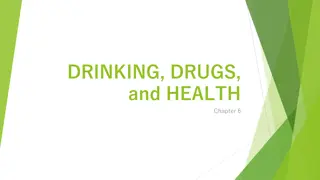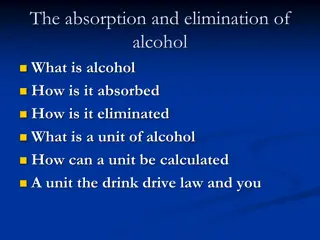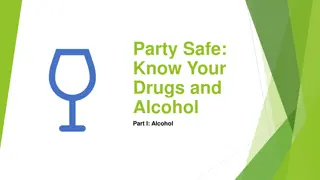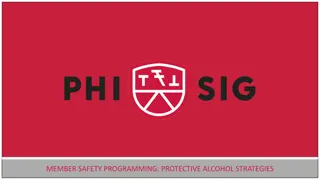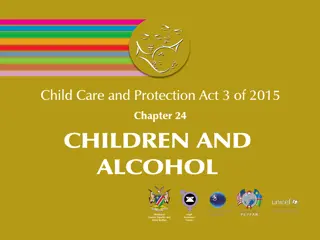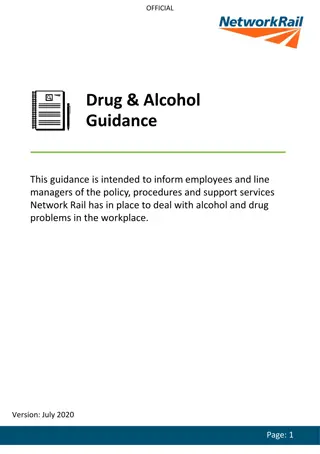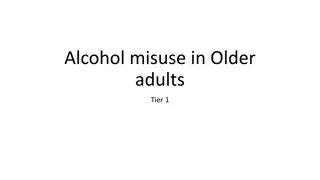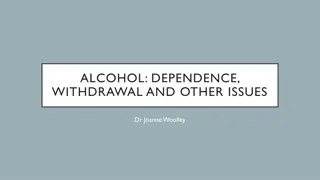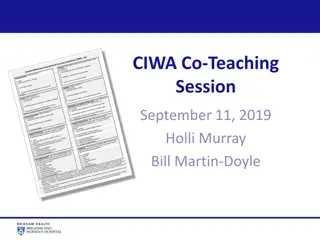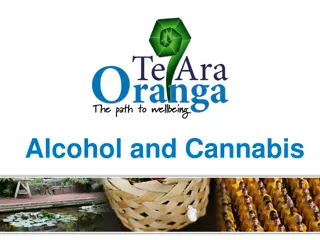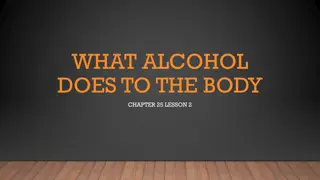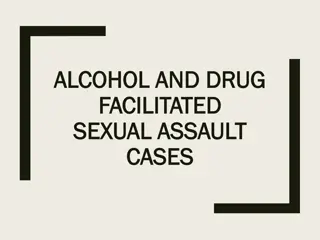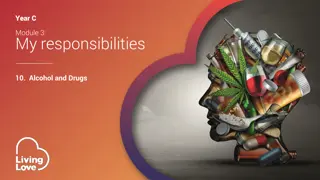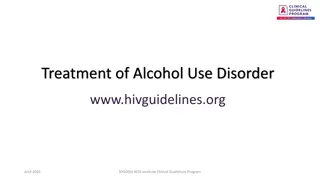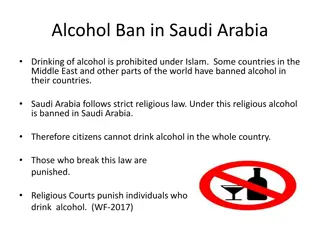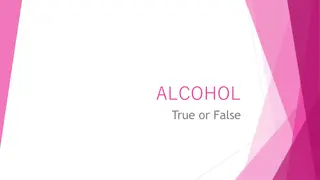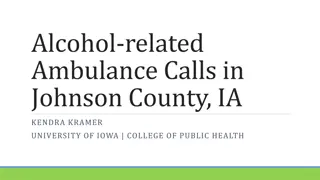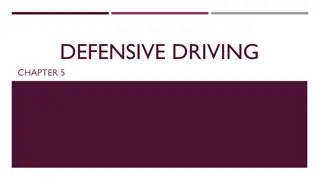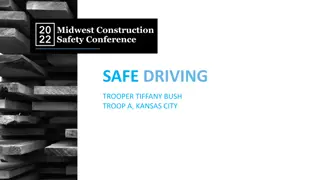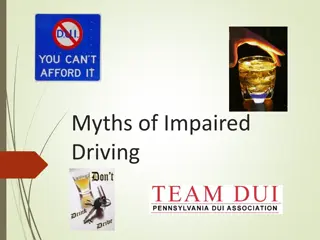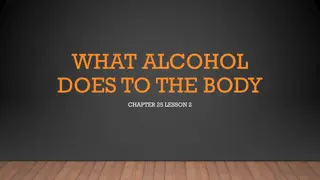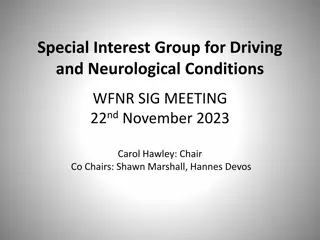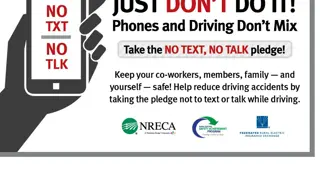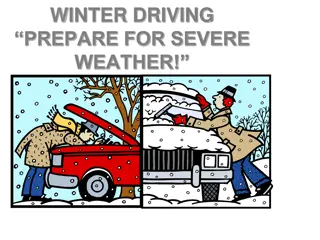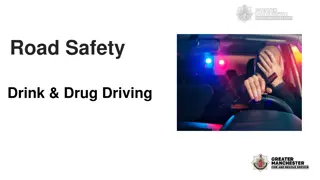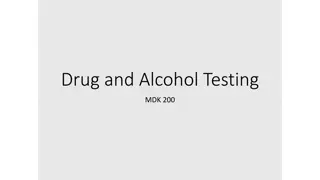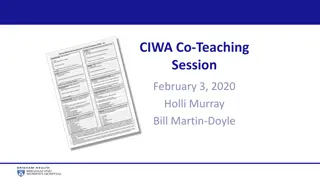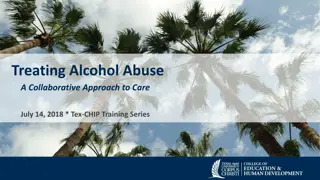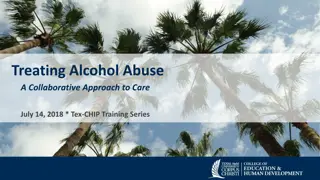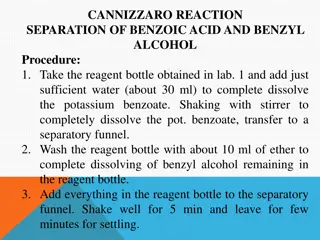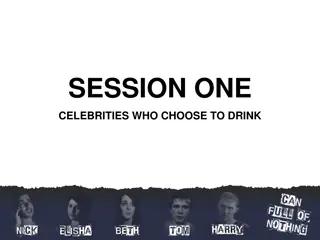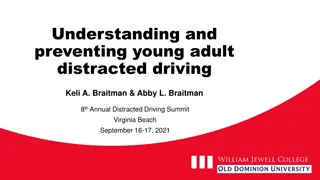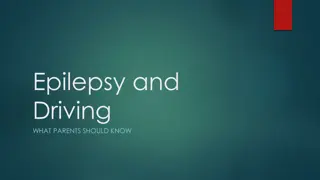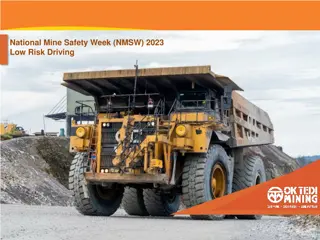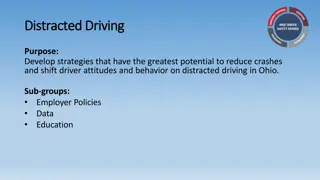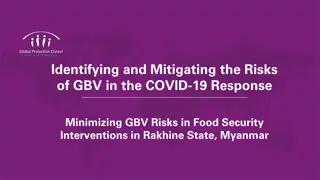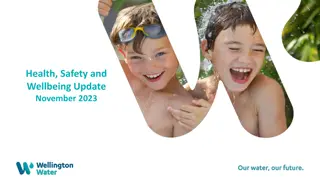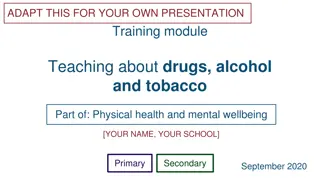Understanding the Risks of Alcohol on Driving
Explore the impact of alcohol on driving, learn about standard drinks, factors affecting Blood Alcohol Concentration (BAC), and journal activities to enhance understanding of safe driving practices. Stay informed to reduce risks on the road.
Uploaded on Jul 16, 2024 | 0 Views
Download Presentation

Please find below an Image/Link to download the presentation.
The content on the website is provided AS IS for your information and personal use only. It may not be sold, licensed, or shared on other websites without obtaining consent from the author. Download presentation by click this link. If you encounter any issues during the download, it is possible that the publisher has removed the file from their server.
E N D
Presentation Transcript
Lesson 6 Reducing Risks Keys 4 Life 7thEdition 2020 Page 95-112
Learning intention Activity 6.1 Zero Alcohol Students develop an understanding of alcohol and other drugs on driving. Road Safety Commission - Drink Driving- just over (31sec)
Define a standard drink A standard drink contains 10 it is used to help calculate the amount of alcohol in the blood stream or the Blood Alcohol Concentration (BAC). For example, a BAC of 0.05 means that a person has 0.05 grams of alcohol in his/her body for every 100ml of blood. ___ grams of pure alcohol and
How Much is a Standard Drink? Type %Alc/Vol Standard Drinks 0.8 standard drink per 285 ml 1 standard drink per 375 ml 1 standard drink per 100 ml 1 standard drink per 30 ml 1.5 standard drinks per 375 ml 1 standard drink per 285 ml 1.5 standard drinks per 375 ml Mid strength beer glass 3-4% Mid strength beer can 3-4% Wine 10-14% Spirits 37-43% Pre-mixed drinks 5% Full strength beer glass 4-6% Full strength beer can 4-6% Reference: Road Safety Commission
Factors affecting a persons BAC The use of other drugs This won t affect BAC but may mask the effect of alcohol. Stimulants such as speed and ecstasy may make a person feel more sober than they really are and cause severe dehydration. Cannabis or other depressants such as analgesics and cold and flu tablets, combined with alcohol, decrease alertness and motor skills more than just consuming alcohol alone. Alcohol combined with some antibiotics may cause headaches, nausea and flushing and reduce the effectiveness of the antibiotics. that breaks down alcohol before it enters the blood. The container size It is the number of standard drinks not the number of glasses that determines BAC. One glass may contain several standard drinks. the rate at which alcohol passes into the bloodstream. because the alcohol takes time to be absorbed. Whether the person is male or female Women s bodies have less water and more fatty tissue than men s, so the alcohol in the water in their system is more concentrated. BAC is also likely to be higher just before a woman s menstruation than any other time. Men make more of the protective enzyme Drinking quickly The time since last drink Amount of body fat Percentage of alcohol in a drink The higher the percentage, the higher the than large framed people who have drunk Type of build Small framed people may have a higher BAC Metabolic rate which is affected by Drinking on an empty stomach Having food in the stomach slows down Fizzy drinks are absorbed more quickly. drink per hour. drink per hour so the BAC may still be rising several hours after drinking has stopped proportion of body fat. the same amount. hormonal cycle. Metabolic rate The type of alcohol The body can only metabolise one standard The body can only break down one standard Body fat does not absorb alcohol so alcohol is more concentrated in people with a high BAC. diet, digestion, fitness, emotional state,
Journal Activities Journal Activity P21 to drive or not to drive class response
Learning intention Activity 6.2 Signs of Fatigue Students develop an awareness of the effects of fatigue on driving. Road Safety Commission- The science of sleep (1.01min)
What is Fatigue? Fatigue (or tiredness) is the silent killer on our roads and could be responsible for up to 30% of deaths and a bigger percentage of serious injury crashes. Statistics show that most fatigue crashes happen between 2am and 5am and 2pm and 5pm when a driver s alertness is low. Fatigue road deaths and injuries happen on country and city roads. It s not just people driving long distances who are at risk of having these crashes. Shift workers, people who work long days, students and those socialising into the early hours of the morning, can easily tune out for a fatal few seconds.
A Tired Driver LOOKS LIKE (include actions and driving behaviour) Yawning Rubbing eyes Eyes closed Slumped in seat Resting head on hand Head back on head rest Nodding head Blinking Car drifting between lanes Car drifting off the road Going faster Slowing unintentionally Braking late FEELS LIKE (include actions and behaviour) Daydreaming Wandering thoughts Forgetting driving the last few kilometres Missing a gear, road sign or exit Sleepy Relaxed Restless Heavy body and/or head Eyes closing for a moment or going out of focus SOUNDS LIKE (include thoughts and comments) Yawning Clunk from hitting kerb or audible edging strips Not talking Have I passed the turn off yet? What speed is it along here? I m okay. I can go a bit further. I ll stop in another 10 minutes I just want to get there
Brainstorm.Strategies to reduce fatigue get plenty of sleep the night before starting out have a 10 minute power nap after stopping at a rest area during the trip avoid alcohol or medications that cause drowsiness have a coffee stop combined with a stretch your legs plan the trip into manageable distances and swap drivers every two hours share the driving time drive hydrated (dehydration can cause headaches, tiredness and light- headedness which can contribute to fatigue and affect driving) avoid driving at night at normal sleep times.
Learning intention Activity 6.3 Driver Distractions Explore the range of distractions that can impact drivers and strategies to mitigate them Road Safety Commission- The distance of distraction- Pram (0.30min)
Driver Distractions Outside the car Roadside advertising Illuminated road works Warning signs Animals near road side Other road users Oncoming headlights Wet weather Detours Inside the car Unruly passengers Changing radio channels or a CD Lighting a cigarette Eating food or drinking Pets moving around Using a mobile phone Upset children Cleaning a foggy windscreen Predictable Pets moving around unrestrained Passenger noise Using the radio Reading a street directory Unpredictable Mobile phone calls Animal running onto the road Other road users Dropping a cigarette, food or hot drink Passenger being sick or argumentative
What can you do to avoid driver distractions? What planning could prevent this from happening? What can the driver do? What can the passenger do? Scenario Driver s mobile phone keeps ringing ? Passenger is drunk and feels like they are going to be sick Passengers are passing food to the driver to eat The driver and a passenger are arguing Passenger keeps turning the music up loud
Scenario: Lets Practice - Role Play The front passenger keeps trying to show the driver something on their mobile phone. Hey check this out!
Scenarios 3. It s raining and the windscreen has fogged up. The front seat passenger decides to keep wiping the windscreen so the driver can see. 1. A passenger feels scared because the driver is angry and it s affecting her ability to drive safely. She asks the driver, who is her friend, to stop the car. 5. A group of friends have been to a party. The driver hasn t been drinking but everyone else has. The four passengers in the car are all laughing loudly and being stupid. One of them has taken off their seatbelt to reach into the front and change the music to the station they want to listen to. 2. A group of friends have bought a pizza to share on the way to the beach. The front seat passenger decides to feed the driver so she doesn t miss out. 4. A pillion passenger is pointing to interesting things along the side of the road. The motorcyclist keeps taking their eyes off the road to look at these.
Journal Activities Behind the wheel Task 4 Be aware of distractions (page 7)
Road Rule: Crossing continuous white lines Road Safety Commission Get Streetwise Crossing continuous white lines
For Teachers/Agencies only- Find out more links from resource: From the Keys 4 Life teacher resource 2020 edition 7 Lesson 6 Road Safety Commission Mobile phone (information and videos) https://www.rsc.wa.gov.au/Your-Safety/Behaviours/Distractions/Mobile-Phones Road Safety Commission Distracted driving (Information) https://www.rsc.wa.gov.au/Your- Safety/Behaviours/Distractions/Distracted-Driving Road Safety Commission Fatigue (Information and videos) https://www.rsc.wa.gov.au/Your- Safety/Behaviours/Fatigue WALGARoadWise Child car restraints http://www.roadwise.asn.au/childcarrestraints.aspx Kidsafe Child car restraints http://www.kidsafewa.com.au/child-carrestraints-road Department of Transport Seats and seatbelts https://www.transport.wa.gov.au/licensing/seats- and-seat-belts.asp
For Teachers/Agencies only- Find out more links from resource: Penalties for some common road rules are provided at: Department of Transport Driver rules, penalties and infringements http://www.transport.wa.gov.au/licensing/driverrules- penaltiesinfringements.asp Road Safety Commission Rules and penalties https://www.rsc.wa.gov.au/Rules-Penalties Drive Safe: A handbook for Western Australian road users Appendix 3: Penalties for traffic offences https://www.transport.wa.gov.au/licensing/rules-of-the-road.asp School Drug Education and Road Aware Challenges and Choices https://www.sdera.wa.edu.au/resources/secondary-resources/challenges- and-choicesdrug-education-resources/ School Drug Education and Road Aware Drug Talk https://www.sdera.wa.edu.au/programs/drug-talk/
For Teachers/Agencies only- Find out more links from resource: Department of Transport Road rules theory test quiz https://www.transport.wa.gov.au/licensing/road-rules-theory-testquiz.Asp Road Safety Commission Your safety Drink stupid Drive stupid https://www.rsc.wa.gov.au/Your-Safety/Games Road Safety Commission Drink driving (Information and videos) https://www.rsc.wa.gov.au/Your-Safety/Behaviours/Drink-Driving Road Safety Commission Drug driving (Information) https://www.rsc.wa.gov.au/Your-Safety/Behaviours/drug-driving
For Teachers / Agencies only: Website links from resource From the Keys 4 Life teacher resource 2020 edition 7 Lesson 5 Students practise test questions with a parent or adult family member, using the eleven online sample quizzes at https://www.transport.wa.gov.au/licensing/road-rules-theory-test-quiz.asp Your Secure Identity (https://www.transport.wa.gov.au/licensing/proof-of- identity.asp) describes the five (5) forms of identity required for the application process, of which: FIND OUT MORE Department of Transport Road rules theory test quiz https://www.transport.wa.gov.au/licensing/road-rules-theory-test-quiz.asp
For Teachers / Agencies only- Quick links From the Keys 4 Life teacher resource 2020 edition Teachers register for the Portal by creating an access account at https://keys4life.ziparchive.com.au/. Have your Keys4Life Access Number ready and use it to log in to: www.northsidelogistics.com.au The Agency order form is available at: www.sdera.wa.edu.au/programs/keys4life/


